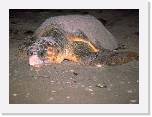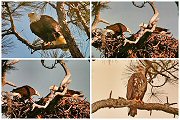 The
2021-2022 season is the 15th consecutive year for eagles to nest on the
island.
Historically, there was a nest reported at the Scharrer homestead, and
the female eagle was reported to have been shot on the nest, according
to a Clearwater Sun article and notes from Myrtle Scharrer Betz in
1935. This new nesting occurance was the first time eagles have
reestablished nesting on the island since
the 1935 homestead nest.
The
2021-2022 season is the 15th consecutive year for eagles to nest on the
island.
Historically, there was a nest reported at the Scharrer homestead, and
the female eagle was reported to have been shot on the nest, according
to a Clearwater Sun article and notes from Myrtle Scharrer Betz in
1935. This new nesting occurance was the first time eagles have
reestablished nesting on the island since
the 1935 homestead nest.Eagles may live up to 40 years. Once mating occurs, after 5 days of internal gestation, the first leg is ready to be laid. Eggs are laid 36 hours apart, Both male and female incubate. Average gestation in the egg is 35 days, with eggs hatching one at a time 36 hours apart. Eaglets remain in nest 10 to 12 weeks. Both parents feed young. Fledglings broaden their range slightly away from the nest over a period of 4 to 8 weeks. Young become independent of parents for food at approximately 17 to 20 weeks.
Honeymoon Island Eagle Nesting 2021-2022: Sept. 2021 - 2 Returning adult eagles and a juvenile were first observed. - May 2022 - 2 juvenile eagles successfully fledged
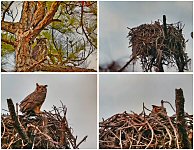 2
resident adult Great
Horned Owls are present on the island this season. They again
selected the same previous osprey nest used used 2 years ago. The site
is .3 miles from the trailhead on the west side of the trail.
2
resident adult Great
Horned Owls are present on the island this season. They again
selected the same previous osprey nest used used 2 years ago. The site
is .3 miles from the trailhead on the west side of the trail.Mating occurs in late December to January. 3 to 4 eggs are laid in January or February. Incubation averages 28 to 35 days. They hatch over a period of time corresponding to the time the eggs were laid. The female incubates while the male hunts and protects the nest. He continues to fend for the family once the owlets hatch. Owlets open eyes at 1 week. They first leave nest in 4 to 5 weeks. They remain nest the nest and fledge fully at 10 weeks. They will remain perched on limbs, and in their parents are for up to 1 year, when they are then sexually mature.
Great Horned Owl Nesting 2021-2022: December, 2021 - Owls nesting in pine at picnic area parking lot. April 2022: 2 chicks successfully fledged.
Osprey
Nesting
2021-2022: Honeymoon 5
Active Nests
 Nesting
season runs from May through October. Daily
beach patrols are conducted during this time, and
nests are protected by a wire cage to
prevent predation from raccoons, ghost crabs, and other would be
predators, and to prevent
disturbance by beach goers. Loggerheads
prefer the
warmer sandy beach
areas further south of here. The barrier islands this far north along
the west coast are typically not heavily used nesting sites, and for
this
reason only a few
Loggerhead nests are observed on our Islands each year. It is estimated
that only 1 in 1000
hatchlings survive to adulthood. Part of the survival success depends
upon natural resource management practices.
Nesting
season runs from May through October. Daily
beach patrols are conducted during this time, and
nests are protected by a wire cage to
prevent predation from raccoons, ghost crabs, and other would be
predators, and to prevent
disturbance by beach goers. Loggerheads
prefer the
warmer sandy beach
areas further south of here. The barrier islands this far north along
the west coast are typically not heavily used nesting sites, and for
this
reason only a few
Loggerhead nests are observed on our Islands each year. It is estimated
that only 1 in 1000
hatchlings survive to adulthood. Part of the survival success depends
upon natural resource management practices.
 Nesting
season runs from May through October. Daily
beach patrols are conducted during this time, and
nests are protected by a wire cage to
prevent predation from raccoons, ghost crabs, and other would be
predators, and to prevent
disturbance by beach goers. Loggerheads
prefer the
warmer sandy beach
areas further south of here. The barrier islands this far north along
the west coast are typically not heavily used nesting sites, and for
this
reason only a few
Loggerhead nests are observed on our Islands each year. It is estimated
that only 1 in 1000
hatchlings survive to adulthood. Part of the survival success depends
upon natural resource management practices.
Nesting
season runs from May through October. Daily
beach patrols are conducted during this time, and
nests are protected by a wire cage to
prevent predation from raccoons, ghost crabs, and other would be
predators, and to prevent
disturbance by beach goers. Loggerheads
prefer the
warmer sandy beach
areas further south of here. The barrier islands this far north along
the west coast are typically not heavily used nesting sites, and for
this
reason only a few
Loggerhead nests are observed on our Islands each year. It is estimated
that only 1 in 1000
hatchlings survive to adulthood. Part of the survival success depends
upon natural resource management practices.Loggerhead Sea
Turtle Nesting 2022:
Kemp's
Ridley Sea Turtle Nesting Activity
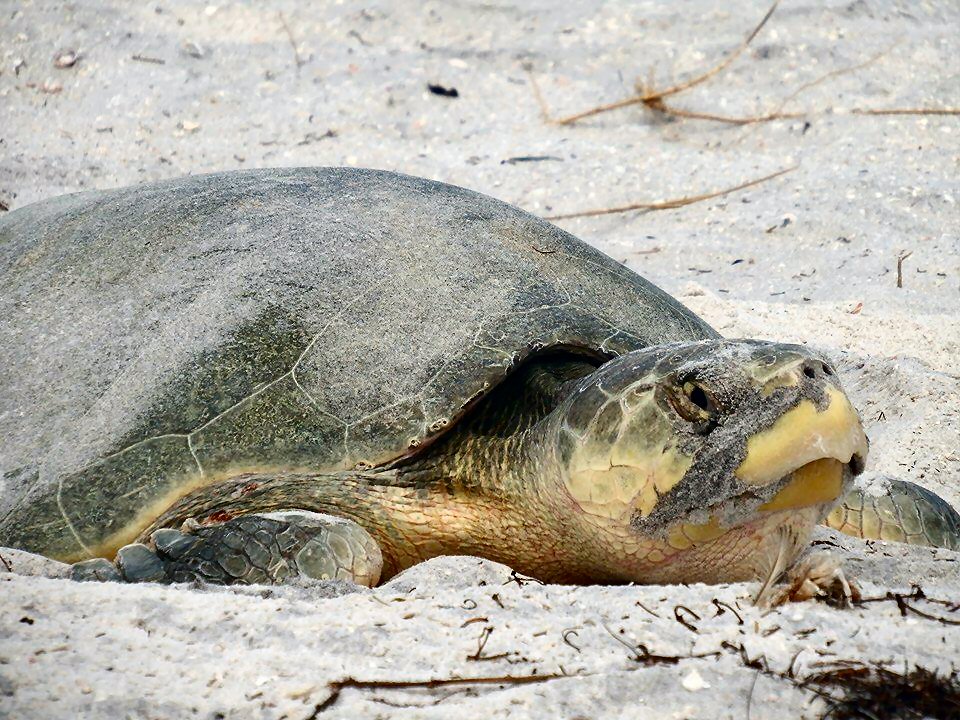 Named
for avid fisherman and naturalist Richard Kemp of Key West. Typically,
this tropical species is not observed nesting here. They nest en mass
in armadas, on windy days at Rancho Nuevo in the Mexican state of
Tamaulipas. They do, however commonly migrate throughout the Gulf of
Mexico from April thru September, and are sometimes seen as far north
as
Nova Scotia. Again, they typically do not nest in these areas. There
are reports of sightings in Ireland as well. Juveniles have a vast
deeper water range, with adults found in a more limited
nearshore
range. They reach maturity as sub adults at 12 years. It is a rare and
critically endangered species, primarily due to human activities such
as egg poaching, trawl nets, gill nets, entanglement, and boat strikes.
There was a previous incident of nesting in 2015 at Caladesi, and also
in 2007 at Anclote,
and this year's nest is the 2nd known case at Caladesi. They are
daytime
nesters, with the nesting process taking only 45 minutes on average.
Adults grow to about 2 feet in length and an average weight of 89 lbs.
They feed in shallow waters and as juveniles they feed at the weed line
and floating mats of sargassum weed, whereby adults are primarily
bottom feeders and prefer crabs and some mollusks, jellyfish and
urchins.
Named
for avid fisherman and naturalist Richard Kemp of Key West. Typically,
this tropical species is not observed nesting here. They nest en mass
in armadas, on windy days at Rancho Nuevo in the Mexican state of
Tamaulipas. They do, however commonly migrate throughout the Gulf of
Mexico from April thru September, and are sometimes seen as far north
as
Nova Scotia. Again, they typically do not nest in these areas. There
are reports of sightings in Ireland as well. Juveniles have a vast
deeper water range, with adults found in a more limited
nearshore
range. They reach maturity as sub adults at 12 years. It is a rare and
critically endangered species, primarily due to human activities such
as egg poaching, trawl nets, gill nets, entanglement, and boat strikes.
There was a previous incident of nesting in 2015 at Caladesi, and also
in 2007 at Anclote,
and this year's nest is the 2nd known case at Caladesi. They are
daytime
nesters, with the nesting process taking only 45 minutes on average.
Adults grow to about 2 feet in length and an average weight of 89 lbs.
They feed in shallow waters and as juveniles they feed at the weed line
and floating mats of sargassum weed, whereby adults are primarily
bottom feeders and prefer crabs and some mollusks, jellyfish and
urchins.
Kemp's Ridley Sea Turtle Nesting 2021 - 2022:
Shorebird Nesting Activity
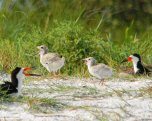 2020-
2021 Shorebird Nesting Season
2020-
2021 Shorebird Nesting Season
A variety of shorebirds nest at Honeymoon Island, Anclote Key Preserve, 3 Rooker Bar and Caladesi Island State Parks, including Black Skimmers, Royal Terns, Sandwich Terns, Caspian Terns, American Oystercatchers, Snowy Egrets. - Shorebird nesting season complete- Successful nesting for BLSK, LAGU, ROYT, SATE, CATE, SNPL, WIPL. LETE and AMOY no fledges. - Wintering PIPL on all islands, report PIPL banded birds to Dan LarremoreL please!
The Infamous Plover "Chicago Rose" is back in town.
"Chicago Rose"
 Named
for avid fisherman and naturalist Richard Kemp of Key West. Typically,
this tropical species is not observed nesting here. They nest en mass
in armadas, on windy days at Rancho Nuevo in the Mexican state of
Tamaulipas. They do, however commonly migrate throughout the Gulf of
Mexico from April thru September, and are sometimes seen as far north
as
Nova Scotia. Again, they typically do not nest in these areas. There
are reports of sightings in Ireland as well. Juveniles have a vast
deeper water range, with adults found in a more limited
nearshore
range. They reach maturity as sub adults at 12 years. It is a rare and
critically endangered species, primarily due to human activities such
as egg poaching, trawl nets, gill nets, entanglement, and boat strikes.
There was a previous incident of nesting in 2015 at Caladesi, and also
in 2007 at Anclote,
and this year's nest is the 2nd known case at Caladesi. They are
daytime
nesters, with the nesting process taking only 45 minutes on average.
Adults grow to about 2 feet in length and an average weight of 89 lbs.
They feed in shallow waters and as juveniles they feed at the weed line
and floating mats of sargassum weed, whereby adults are primarily
bottom feeders and prefer crabs and some mollusks, jellyfish and
urchins.
Named
for avid fisherman and naturalist Richard Kemp of Key West. Typically,
this tropical species is not observed nesting here. They nest en mass
in armadas, on windy days at Rancho Nuevo in the Mexican state of
Tamaulipas. They do, however commonly migrate throughout the Gulf of
Mexico from April thru September, and are sometimes seen as far north
as
Nova Scotia. Again, they typically do not nest in these areas. There
are reports of sightings in Ireland as well. Juveniles have a vast
deeper water range, with adults found in a more limited
nearshore
range. They reach maturity as sub adults at 12 years. It is a rare and
critically endangered species, primarily due to human activities such
as egg poaching, trawl nets, gill nets, entanglement, and boat strikes.
There was a previous incident of nesting in 2015 at Caladesi, and also
in 2007 at Anclote,
and this year's nest is the 2nd known case at Caladesi. They are
daytime
nesters, with the nesting process taking only 45 minutes on average.
Adults grow to about 2 feet in length and an average weight of 89 lbs.
They feed in shallow waters and as juveniles they feed at the weed line
and floating mats of sargassum weed, whereby adults are primarily
bottom feeders and prefer crabs and some mollusks, jellyfish and
urchins.Kemp's Ridley Sea Turtle Nesting 2021 - 2022:
Shorebird Nesting Activity
A variety of shorebirds nest at Honeymoon Island, Anclote Key Preserve, 3 Rooker Bar and Caladesi Island State Parks, including Black Skimmers, Royal Terns, Sandwich Terns, Caspian Terns, American Oystercatchers, Snowy Egrets. - Shorebird nesting season complete- Successful nesting for BLSK, LAGU, ROYT, SATE, CATE, SNPL, WIPL. LETE and AMOY no fledges. - Wintering PIPL on all islands, report PIPL banded birds to Dan LarremoreL please!
The Infamous Plover "Chicago Rose" is back in town.
"Chicago Rose"
